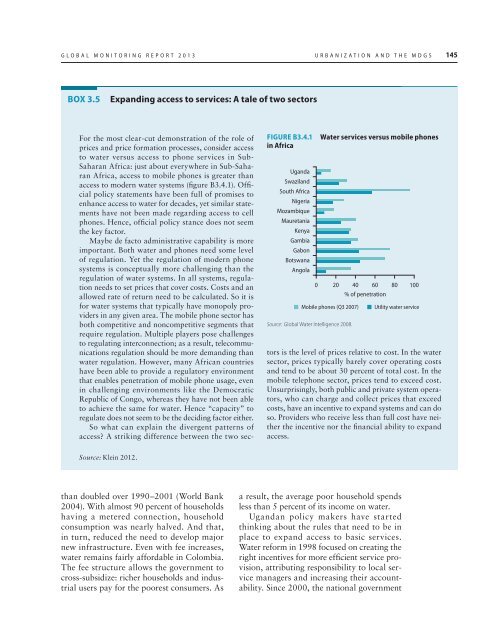rural-urban dynamics_report.pdf - Khazar University
rural-urban dynamics_report.pdf - Khazar University
rural-urban dynamics_report.pdf - Khazar University
Create successful ePaper yourself
Turn your PDF publications into a flip-book with our unique Google optimized e-Paper software.
GLOBAL MONITORING REPORT 2013 URBANIZATION AND THE MDGS 145<br />
BOX 3.5<br />
Expanding access to services: A tale of two sectors<br />
FIGURE B3.4.1<br />
in Africa<br />
Uganda<br />
Swaziland<br />
South Africa<br />
Nigeria<br />
Mozambique<br />
Mauretania<br />
Kenya<br />
Gambia<br />
Gabon<br />
Botswana<br />
Angola<br />
Source: Global Water Intelligence 2008.<br />
Water services versus mobile phones<br />
0 20 40 60 80 100<br />
% of penetration<br />
Mobile phones (Q3 2007)<br />
Utility water service<br />
For the most clear-cut demonstration of the role of<br />
prices and price formation processes, consider access<br />
to water versus access to phone services in Sub-<br />
Saharan Africa: just about everywhere in Sub-Saharan<br />
Africa, access to mobile phones is greater than<br />
access to modern water systems (figure B3.4.1). Official<br />
policy statements have been full of promises to<br />
enhance access to water for decades, yet similar statements<br />
have not been made regarding access to cell<br />
phones. Hence, official policy stance does not seem<br />
the key factor.<br />
Maybe de facto administrative capability is more<br />
important. Both water and phones need some level<br />
of regulation. Yet the regulation of modern phone<br />
systems is conceptually more challenging than the<br />
regulation of water systems. In all systems, regulation<br />
needs to set prices that cover costs. Costs and an<br />
allowed rate of return need to be calculated. So it is<br />
for water systems that typically have monopoly providers<br />
in any given area. The mobile phone sector has<br />
both competitive and noncompetitive segments that<br />
require regulation. Multiple players pose challenges<br />
to regulating interconnection; as a result, telecommunications<br />
regulation should be more demanding than<br />
water regulation. However, many African countries<br />
have been able to provide a regulatory environment<br />
that enables penetration of mobile phone usage, even<br />
in challenging environments like the Democratic<br />
Republic of Congo, whereas they have not been able<br />
to achieve the same for water. Hence “capacity” to<br />
regulate does not seem to be the deciding factor either.<br />
So what can explain the divergent patterns of<br />
access? A striking difference between the two sectors<br />
is the level of prices relative to cost. In the water<br />
sector, prices typically barely cover operating costs<br />
and tend to be about 30 percent of total cost. In the<br />
mobile telephone sector, prices tend to exceed cost.<br />
Unsurprisingly, both public and private system operators,<br />
who can charge and collect prices that exceed<br />
costs, have an incentive to expand systems and can do<br />
so. Providers who receive less than full cost have neither<br />
the incentive nor the financial ability to expand<br />
access.<br />
Source: Klein 2012.<br />
than doubled over 1990–2001 (World Bank<br />
2004). With almost 90 percent of households<br />
having a metered connection, household<br />
consumption was nearly halved. And that,<br />
in turn, reduced the need to develop major<br />
new infrastructure. Even with fee increases,<br />
water remains fairly affordable in Colombia.<br />
The fee structure allows the government to<br />
cross-subsidize: richer households and industrial<br />
users pay for the poorest consumers. As<br />
a result, the average poor household spends<br />
less than 5 percent of its income on water.<br />
Ugandan policy makers have started<br />
thinking about the rules that need to be in<br />
place to expand access to basic services.<br />
Water reform in 1998 focused on creating the<br />
right incentives for more efficient service provision,<br />
attributing responsibility to local service<br />
managers and increasing their accountability.<br />
Since 2000, the national government

















